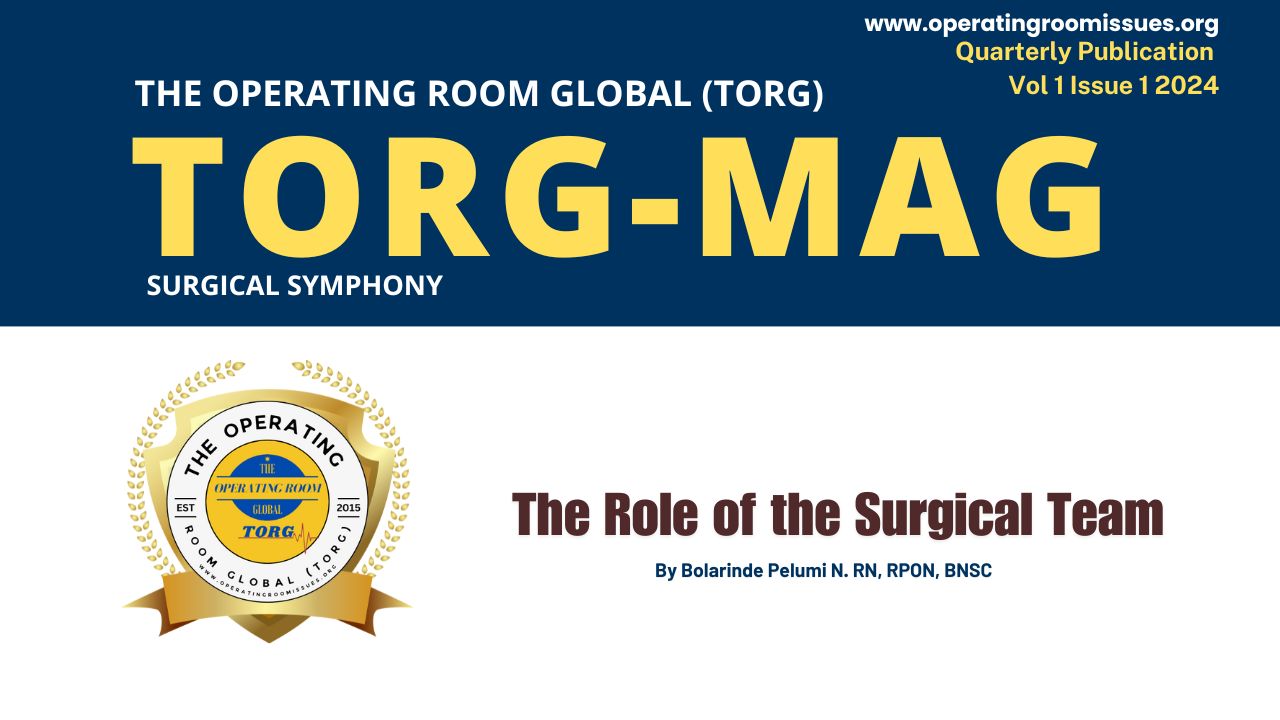By Bolarinde Pelumi N., RN, RPON, BNSc.
TORG-MAG Vol 1 Issue 1, Aug. 2024, PP. 25-26
Cite this article: Pelumi, B.N. (2024) ‘The Role of the Surgical Team’, TORG-MAG, Vol. 1, Issue 1, pp. 25-26. Available at: https://torgevents.org/surgical-team/
Introduction

The operating room (OR) team members usually consist of sterile and unsterile divisions. The surgeon, assistants to the surgeon and the scrub nurse or a surgical technologist forms the sterile division. Patients undergoing surgery will be taken care of the operating room team.
Safety and privacy of patients in the OR is safeguarded by the operating room team members. Personnel inside the OR consist of the operating surgeon, assistants to the surgeon, a scrub person, an anesthesiologist, a surgical technologist and a circulating nurse. Each member of the OR team performs specific function in coordination with one another to create an atmosphere that best benefit the patient.
The team is divided into two divisions according to the function of its members:
Sterile OR team: Operating surgeon, assistants to the surgeon and scrub person
Unsterile OR team: Anesthesiologist or nurse anesthetist, circulator and other OR members that might be needed in operating specialized machine or devices.
Sterile team members:
•Surgeon
•Assistants to the surgeon
•Scrub person (either a registered nurse or surgical technologist)
Sterile operating team:
•The members of the OR sterile team will do the following things:
• Perform surgical hand washing (arms are included).
• Don sterile gowns and gloves.
• Enter the sterile field.
• Handles sterile items only.
• Functions only within a limited area (sterile field).• Wear mask.
Operating Surgeon: The surgeon is a licensed physician (MD), osteopath (DO), oral surgeon (DDS or DMD), or podiatrist (DPM). This professional is especially trained and is qualified by knowledge and experience for the performance of a surgical operation.
Responsibilities of a surgeon
• Preoperative diagnosis and care of the patient
• Performance of the surgical procedure
• Postoperative management of care

Assistant Surgeon: During a surgical procedure, the operating surgeon can have one or two assistants to perform specific tasks under his/her (operating surgeon) direction.
The responsibilities of a surgeon’s assistant:
• Help maintain the visibility of the surgical site
• Control bleeding
• Close wounds
• Apply dressings
• Handles tissues
• Uses instruments
Types of Surgeon Assistants
First Assistants could either be:
• A qualified surgeon or resident in an accredited surgical education program. The first assistant should be capable of assuming the operating surgeon’s responsibility in cases of incapacitation or accidents.
• Registered Nurse and surgical technologists that have a written hospital policy permitting the action.
• Second Assistant could be a registered nurse or surgical technologist. These staff should be trained and they mar retract tissues and suction body fluids to help provide exposure of the surgical site.

Scrub person: A scrub person could be the following:
• Registered Nurse
• Surgical technologist
•Licensed practical/vocational nurse
The responsibility of a scrub person is to maintain the integrity, safety and efficiency of the sterile field throughout the surgical procedure.
Unsterile operating room team: The unsterile operating room members are not allowed to enter the sterile field to prevent contamination. The responsibilities of the members of this team are the following:
•Handle supplies and equipments that are considered unsterile.
•Touches unsterile surfaces only.
•Keep the sterile team supplied with supplies handled aseptically.
•Give direct patient care.
•Assist the sterile team member’s need with strict observation of avoiding contact to the sterile field.
•Handles other requirements arising during the surgical procedure.

Anaesthesiologist/Anaesthetist
Difference between an anaesthesiologist and anaesthetist: An anaesthesiologist is a medical practitioner who is certified by a certain institution while an anaesthetist could either be a qualified and licensed nurse, dentist or a physician who administers anaesthetics. The anaesthetist works under the supervision of an anaesthesiologist or a surgeon when administering a drug or gas.
Responsibilities:
•Choice and application of appropriate agents.
•Choice and application of suitable techniques of administration.
• Monitoring of physiologic function.
•Maintenance of fluid and electrolyte balance.
• Blood replacement.
• Helps in minimizing the hazards of shock, fire and electrocution.
•Use and interpret correctly a wide variety of monitoring devices.
•Overseeing the positioning and movement of patients.
•Oversee the Post Anaesthesia Care Unit (PACU) to provide resuscitative care until the patient has regained vital functions.
Responsibilities of a Circulator
•Monitors and coordinates all activities within the room.
•Manages the care required for each patient.
•Provides assistance to any member of the OR team with strict observation to avoid a break in sterility.
•Creates and maintains a safe and comfortable environment for the patient through the implementation of aseptic technique.
Operating room staff roles are very important for any surgery to be efficient, safe, and successful. It takes a team of extraordinary individuals to come together like a symphony and become in sync with each other to perform amazing surgery procedures daily. Each one of their roles plays a crucial part in the surgical process that provides life longevity for patients. Several hours of research, documentation, and preparation are needed from the start to finish for these procedures.
References
- https://www.rnpedia.com/nursing-notes/medical-surgical-nursing-notes/operating-room-team/
- https://www.incision.care/blog/operating-room-department#:~:text=The%20operating%20team%20members%20usually,gloves%2C%20gowns%2C%20and%20masks.
TORG Magazine (TORG-MAG)
Maiden Edition: Surgical Symphony, Issue 1 Vol 1 Aug 2024
Stay ahead in the field of surgical practice with TORG-MAG, the quarterly publication from The Operating Room Global (TORG).
✓ Fill out the Form Below and submit
